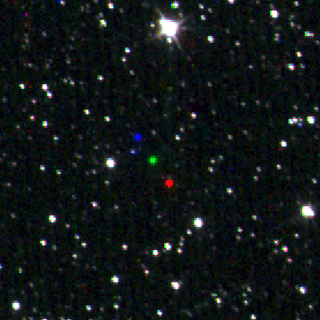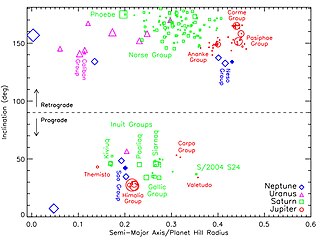Related Research Articles

The moons of Saturn are numerous and diverse, ranging from tiny moonlets only tens of meters across to the enormous Titan, which is larger than the planet Mercury. There are 146 moons with confirmed orbits, the most of any planet in the solar system. This number does not include the many thousands of moonlets embedded within Saturn's dense rings, nor hundreds of possible kilometer-sized distant moons that were seen through telescopes but not recaptured. Seven Saturnian moons are large enough to have collapsed into a relaxed, ellipsoidal shape, though only one or two of those, Titan and possibly Rhea, are currently in hydrostatic equilibrium. Three moons are particularly notable. Titan is the second-largest moon in the Solar System, with a nitrogen-rich Earth-like atmosphere and a landscape featuring river networks and hydrocarbon lakes. Enceladus emits jets of ice from its south-polar region and is covered in a deep layer of snow. Iapetus has contrasting black and white hemispheres as well as an extensive ridge of equatorial mountains among the tallest in the solar system.

Skathi, also named Saturn XXVII and originally spelled Skadi, is a natural satellite of the planet Saturn. Skathi is one of Saturn's irregular moons, in its Norse group of satellites. It was discovered on September 23, 2000, by a team of astronomers led by Brett Gladman. The team announced their discovery on December 7, 2000, along with seven other satellites of Saturn, namely; Tarvos, Ijiraq, Thrymr, Siarnaq, Mundilfari, Erriapus, and Suttungr. The moon was named after Skaði, a figure in Norse mythology, as part of an effort to diversify the largely Greek and Roman names of astronomical objects.

Siarnaq, also designated Saturn XXIX, is the second-largest irregular moon of Saturn. It was discovered on 23 September 2000 by a team of astronomers led by Brett J. Gladman. It was named after the Inuit goddess of the sea, Siarnaq, who is more commonly known as Sedna. Siarnaq is the largest member of Saturn's Inuit group of prograde irregular moons, which orbit far from Saturn in the same direction as the planet's rotation. The moons of the Inuit group are believed to have originated as fragments from the collisional breakup of a larger progenitor moon after it was gravitationally captured into orbit around Saturn several billion years ago. Several other small Inuit group moons share similar orbits to Siarnaq, indicating that the moon had experienced another collision after forming from its progenitor.

The Norse group is a large group of retrograde irregular satellites of Saturn. Their semi-major axes range between 12 and 27 Gm, their inclinations between 136° and 178° and their eccentricities between 0.06 and 0.63. Unlike the Inuit and Gallic groups, the orbital parameters are widely dispersed and the group is likely to be composed from a number of subgroups with more homogeneous orbital and physical parameters. The International Astronomical Union (IAU) reserves names taken from Norse mythology for these moons. The exception is Phoebe, the largest, which was discovered long before the others.

In astronomy, an irregular moon, irregular satellite or irregular natural satellite is a natural satellite following a distant, inclined, and often eccentric and retrograde orbit. They have been captured by their parent planet, unlike regular satellites, which formed in orbit around them. Irregular moons have a stable orbit, unlike temporary satellites which often have similarly irregular orbits but will eventually depart. The term does not refer to shape; Triton for example, is a round moon, but is considered irregular due to its orbit.
S/2020 S 1 is a natural satellite of Saturn. Its discovery was announced by Scott S. Sheppard, David C. Jewitt, Jan Kleyna, Edward Ashton, Brett J. Gladman, Jean-Marc Petit and Mike Alexandersen on May 3, 2023 from observations taken between December 14, 2004 and July 8, 2021.
S/2006 S 20 is a natural satellite of Saturn. Its discovery was announced by Scott S. Sheppard, Brett J. Gladman, Edward Ashton, David C. Jewitt and Jan Kleyna on May 23, 2023 from observations taken between January 5, 2006 and July 9, 2021.
S/2007 S 5 is a natural satellite of Saturn. Its discovery was announced by Scott S. Sheppard, David C. Jewitt, Jan Kleyna, Edward Ashton, Brett J. Gladman, Jean-Marc Petit and Mike Alexandersen on May 3, 2023 from observations taken between January 5, 2005 and July 9, 2021.
S/2019 S 2 is a natural satellite of Saturn. Its discovery was announced by Edward Ashton, Brett J. Gladman, Jean-Marc Petit and Mike Alexandersen on May 3, 2023 from observations taken between July 3, 2019 and July 9, 2021.
S/2020 S 7 is a natural satellite of Saturn. Its discovery was announced by Edward Ashton, Brett J. Gladman, Jean-Marc Petit and Mike Alexandersen on May 10, 2023 from observations taken between July 1, 2019 and July 24, 2020.
S/2019 S 14 is a natural satellite of Saturn. Its discovery was announced by Edward Ashton and Brett J. Gladman on May 10, 2023 from observations taken between July 1, 2019 and July 9, 2021.
S/2020 S 3 is a natural satellite of Saturn. Its discovery was announced by Edward Ashton, Brett J. Gladman, Jean-Marc Petit and Mike Alexandersen on May 5, 2023 from observations taken between July 3, 2019 and July 9, 2021.
S/2019 S 6 is a natural satellite of Saturn. Its discovery was announced by Edward Ashton and Brett J. Gladman on May 8, 2023 from observations taken between July 3, 2019 and July 8, 2021.
S/2020 S 5 is a natural satellite of Saturn. Its discovery was announced by Edward Ashton, Brett J. Gladman, Jean-Marc Petit and Mike Alexandersen on May 6, 2023 from observations taken between July 3, 2019 and July 9, 2021.
S/2004 S 43 is a natural satellite of Saturn. Its discovery was announced by Scott S. Sheppard, David C. Jewitt, Jan Kleyna, Edward Ashton, Brett J. Gladman, Jean-Marc Petit and Mike Alexandersen on May 7, 2023 from observations taken between December 12, 2004 and July 9, 2021.
S/2019 S 13 is a natural satellite of Saturn. Its discovery was announced by Edward Ashton, Brett J. Gladman, Jean-Marc Petit and Mike Alexandersen on May 9, 2023 from observations taken between July 3, 2019 and July 8, 2021.
S/2005 S 5 is a natural satellite of Saturn. Its discovery was announced by Scott S. Sheppard, David C. Jewitt, Jan Kleyna, Edward Ashton, Brett J. Gladman, Jean-Marc Petit and Mike Alexandersen on May 10, 2023 from observations taken between March 9, 2005 and July 24, 2020.
S/2006 S 18 is a natural satellite of Saturn. Its discovery was announced by Scott S. Sheppard, David C. Jewitt, Jan Kleyna, Edward Ashton, Brett J. Gladman, Jean-Marc Petit and Mike Alexandersen on May 15, 2023 from observations taken between December 14, 2004 and July 9, 2021.
S/2006 S 19 is a natural satellite of Saturn. Its discovery was announced by Scott S. Sheppard, David C. Jewitt, Jan Kleyna, Edward Ashton, Brett J. Gladman, Jean-Marc Petit and Mike Alexandersen on May 15, 2023 from observations taken between January 5, 2006 and July 9, 2021.
S/2019 S 21 is a natural satellite of Saturn. Its discovery was announced by Scott S. Sheppard, David C. Jewitt, Jan Kleyna, Edward Ashton, Brett J. Gladman, Jean-Marc Petit and Mike Alexandersen on May 16, 2023 from observations taken between February 2, 2006 and July 8, 2021.
References
- 1 2 "Planetary Satellite Mean Elements". Jet Propulsion Laboratory. California Institute of Technology. Retrieved 3 May 2023.
- ↑ "MPEC 2023-J22 : S/2006 S 9". Minor Planet Electronic Circular. Minor Planet Center. Retrieved 3 May 2023.
- ↑ "S/2006 S 9". Tilmann's Web Site. Tilmann Denk. Retrieved 23 December 2023.